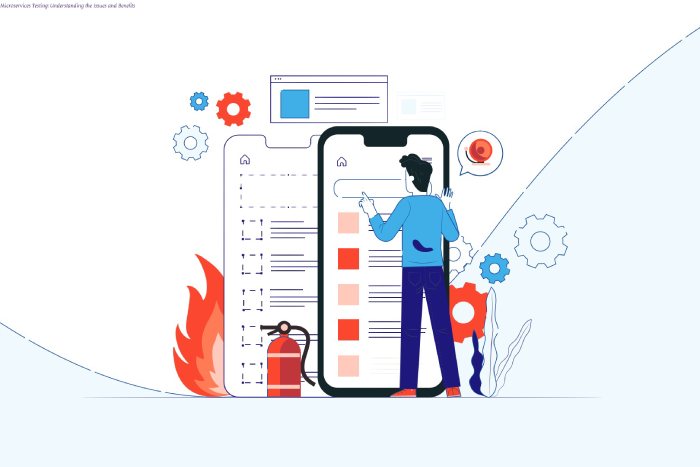Microservices Testing: Understanding the Issues and Benefits

Microservices Testing: Understanding the Issues and Benefits
Microservices is a software design practice in which an application comprises tiny independent services for constructing cloud applications. Scalability, improved communication, robustness, and maintainability are all advantages of microservices. However, testing is prone to issues due to the complexity of the microservices design.
Businesses nowadays want solutions that are adaptable and scalable. To fulfill the ever-changing demands of consumers, they want quick and dependable answers. Microservices testing guarantees that applications run efficiently. Nonetheless, the emergence of microservices architecture has made testing difficult. In this post, we will discuss some of the challenges and advantages of microservices testing and how it may help organizations optimize their operations. Let’s get started!
Table of Contents
Microservices Testing Challenges in 2023
Integration Testing and DebuggingA QA professional should be familiar with every service the program provides to build integration tests. Furthermore, it is common for one service component to need to be made aware of the existence of other service components. Because microservices-based solutions are complicated, each service should be tested individually. As a result, there is a potential that some service capabilities will not be tested. Collaboration across services becomes difficult in end-to-end testing as well. To make matters worse, running end-to-end tests will be more expensive. Furthermore, delayed test automation systems make providing reliable feedback problematic.
1. Lack of Cooperation
Because numerous teams are working on improving functionality simultaneously, unifying the entire software development is challenging. More minor independent services are distributed on many servers in a microservices architecture. It necessitates synchronizing various pieces, which becomes nearly tricky when the application’s usage suddenly increases.
2. Architecture that is decoupled
Each component of a decoupled microservice architecture may complete tasks separately. Each microservice has its database that is independent of the others. However, in other situations, a decoupling database is not required. As a result, verifying the microservices that require decoupled architecture necessitates careful consideration.
3. Problems with Design
Building microservices is more complicated than building monolithic architecture. Determining its size, connecting points, service integration architecture, and many other factors takes a lot of work. Each microservice serves a specific purpose and does not cover every business element. Designers may need help to determine the proper boundaries and scale for microservices.
4. Re-architecting Software
Software developers must work hard to rebuild the application to function following the microservices architecture. It is always possible, especially in huge organizations with complex systems. Re-architecting entails removing the application from the main codebase and modifying the current codebase.
The Advantages of Microservices Testing
Microservices architecture has recently emerged as a popular choice for developing and deploying sophisticated software programs. Microservices divide software into smaller components, each with its responsibilities. Let’s look at some advantages of microservices design and why it’s chosen.
1. Easy to construct
Microservices use less code than other types of applications. They also perform better in testing and make incremental code modifications easier. It needs less testing effort and reduces hazards. Furthermore, users do not need to be concerned about one job interfering with another. Furthermore, no specific communications format is required. While working on separate technologies, several developers can collaborate on the same microservice design.
2. Scalability
Because of numerous separate components, it is commonly assumed that performance in microservices design suffers. However, if the workload grows in size and data volume, installing new microservices to alleviate the strain by using more hardware resources is simple. Handling increased load, on the other hand, necessitates multiple substantial modifications in monolithic design, which increases the likelihood of mistakes.
3. Simple Deployment
When compared to monolithic apps, microservice architecture is easier to deploy. It is built, and they are easy to build because they are little.
Microservices are great for deployment with other technologies because they lack dependency conflicts. Above all, microservices architecture may be deployed in serverless settings, the cloud, edge computing, or on-premises. When employing microservices, the possibilities are limitless.
4. Applying New Technologies
Unlike a monolithic design, each microservice is technically autonomous, with no dependence problems. Changes are simple, and there are fewer codes. As a result, businesses may store information using a variety of methods. It merely provides developers with the option to test and explore. Also, only upgrade important app components that use new technologies.
Conclusion
If you intend to use microservices, ensure you have the best platform for designing microservices. Also, describe your goals for your microservice platform. It is essential to determine the appropriate service size and to decide whether to rewrite or divide existing services. Microservices testing offers both advantages and disadvantages. It is always prudent to design automated testing to maximize the benefits of microservices architecture while mitigating any issues.
Also read:-How Can You Avoid Browser Fingerprinting?




